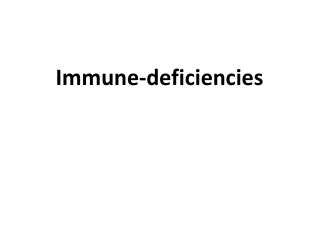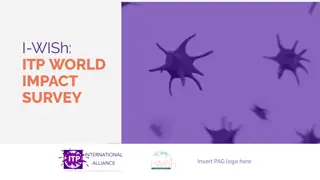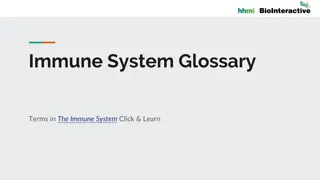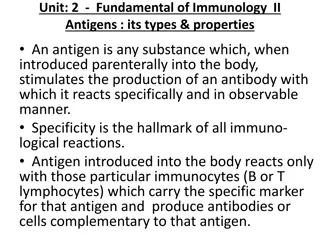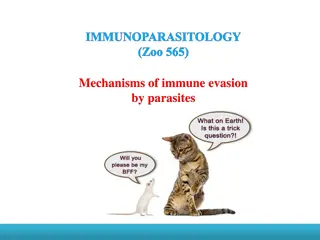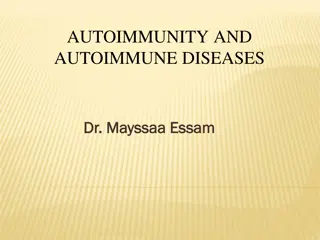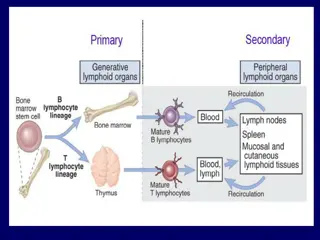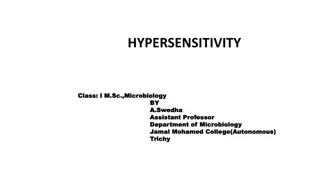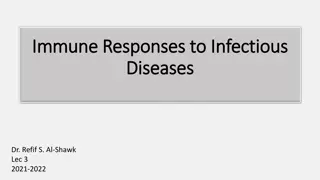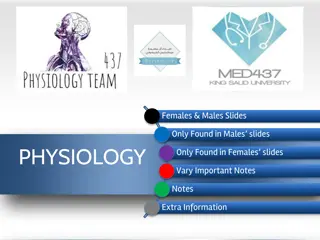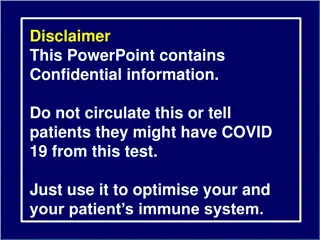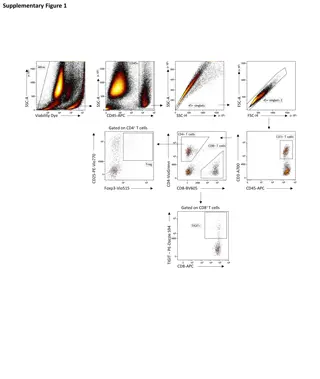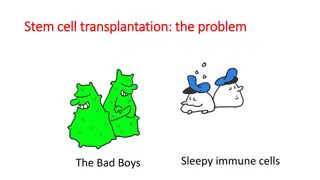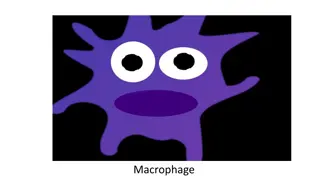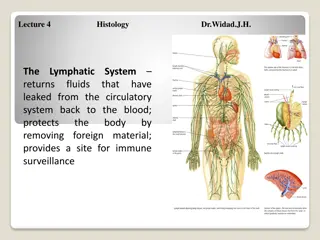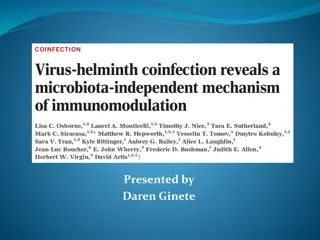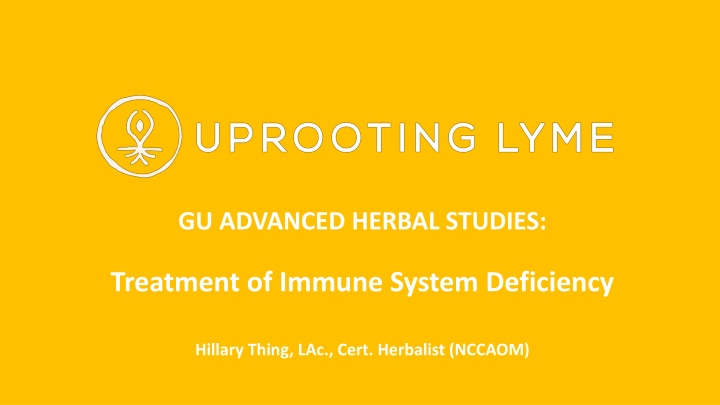
Herbal Strategies for Boosting Immune System Function
Explore advanced herbal studies focusing on the treatment of immune system deficiency, including insights on the immune system, activation of NK cells, symptoms of immune deficiency, and concepts of the immune system in Chinese Medicine. Learn about natural remedies to enhance immune health and vitality.
Download Presentation

Please find below an Image/Link to download the presentation.
The content on the website is provided AS IS for your information and personal use only. It may not be sold, licensed, or shared on other websites without obtaining consent from the author. If you encounter any issues during the download, it is possible that the publisher has removed the file from their server.
You are allowed to download the files provided on this website for personal or commercial use, subject to the condition that they are used lawfully. All files are the property of their respective owners.
The content on the website is provided AS IS for your information and personal use only. It may not be sold, licensed, or shared on other websites without obtaining consent from the author.
E N D
Presentation Transcript
GU ADVANCED HERBAL STUDIES: Treatment of Immune System Deficiency Hillary Thing, LAc., Cert. Herbalist (NCCAOM)
The Immune System involves: The Immune System involves: The endocrine system, psychoneuroimmunology, the gut RBC, WBC & platelets are produced in bone marrow from stem cells; T & B cell lymphocytes are also produce in the lymph nodes and spleen; & T cells are produced and mature in the thymus WBCs last a short time (hours days) and must be replaced constantly; Natural Killer (NK) cells are type of WBC (T cell); small %, elite force -> control tumors and microbial infections
Activation of NK Cells Activation of NK Cells Deficient NK cells (as measured by the CD 57 lab) is strongly associated with chronic viral infection, CFS, MS, some auto- immune conditions such as RA & Lupus, and cancer. Activated NK cells secrete cytokines such as interferon and TNF-alpha; Th1 dominance (IL-12, IL-2) increases NK cell activity Impairment of NK cells is also associated with advanced aging. They are present in all tissue throughout the body, and are your best protection against chronic infection.
Symptoms & Signs of Immune Deficiency in Symptoms & Signs of Immune Deficiency in Lyme Lyme Dx Dx Poor energy Poor responsiveness to treatment Recurrences, can t stay off abx Multiple layers of infection History of chronic viral infection (EBV, CFS) or possibly cancer Long-time illness Low CD 57 (normal = 60-360; healthy > 150) Low Vitamin D3
Concepts of the Immune System in CM Concepts of the Immune System in CM 1. Wei-Defensive qi & Yuan-source qi Qi deficiency generally involves problems with the process of post- natal qi production (see Gu-GI class); In Ming D. comes notion that Kidney Qi-energy is responsible for supporting all aspects of life. Yang deficiency generally involves warming and protecting (immune function) Kidney exerts overall systemic support via Ming Men Fire & San- Jiao (as exerted through the UB channel shu-transport points) The immune system weakens w/ age due to decline of jing- essence.
3 Levels of Immune System 3 Levels of Immune System Wei / Defensive Qi -> Circulates throughout exterior via Lungs; enters interior to protect internal organs @ night. Ying / Nourishing Qi -> Circulates throughout interior to maintain organ strength; relates to blood, body fluids and hormones Yuan / Source Qi -> Rooted in Kidney yin & yang. Called upon when resources at the wei and ying levels become depleted.
Boosting Post Boosting Post- -Natal Qi boosts immunity Natal Qi boosts immunity - -> > RECAP of factors to consider RECAP of factors to consider Opening the Stomach (sha ren / cardamom) Rotting & ripening of grain (food) qi based on Stomach fire may be excess or deficient; may injure other organs Food stagnation Lingering unresolved pathogens lead to Dampness, which injures Spleen Damp, damp-heat, damp-cold, phlegm, turbid congestion Stress leading to Liver overacting on Spleen / Stomch Poor Da / Great Qi from Lungs (breathe like it s a meal) ALWAYS UTILIZE POST-NATAL QI MODEL OR TONICS WON T HAVE GOOD EFFECT!
Review of Post Review of Post- -Natal Qi into Immune Natal Qi into Immune Sx Sx Power: Power: Gu / grain qi + Da / Great Qi occurs in chest -> Zhen / True Qi Zhen / True Qi = wei / defensive qi (exterior) + ying / nourishing qi (interior) Same as zheng / Upright Qi that is utilized against xie / perverse (evil) qi. (so- called when qi is in struggle w/ pathogen) Any surplus of zhen qi = jing qi (essence); retards aging. Modern strategies tend to focus on strengthening (jian) or tonifying (bu) the zang organs that are responsible for qi formation (i.e. LU, SP); this is a flawed approach! Must understand functional process of post-natal qi production and address all complications / dysfunctions before even considering the tonification of Qi.
Gu (Grain) Acupuncture Points Gu (Grain) Acupuncture Points Dynamics of exterior to interior occur @ shu-stream pts; ST 43, Xian gu, descend into valley tx rebellious ST qi. KI must have fire to support Spleen to ascend the gu qi to chest; @ KI 2 branch to SP 8, xi-cleft pt; di ji Earth in Flight; pt to ascend gu qi to chest; before SP8 is SP 7, Lou Gu / Leaking Valley a/t that can t ascend falls down; tx leaky gut, diarrhea, dysentery, prolapse (sp qi sinking) Tx leaky gut: moxa KI 2 & SP 8, needle SP 7 LI 4, He gu, union valley, source point; gives birth to yin & yang; ying & wei qi Most yin organ = kidney (water element); water point = KI 10, Yin Gu to support more yin in digestion, in body as whole Most yang organ = yang organ SI fire point = SI 5, yang gu to support more yang via digestion Names reflect gu qi model / post-natal qi paradigm. Instead of moxa can apply clove or garlic oil
Kidneys are the root of Yin & Yang Kidneys are the root of Yin & Yang 2 Basic Roles in Immune System Alchemical process of SJ (dan tien) harnessing / banking KI essence converts acquired essence from Liver blood and LU qi (gyn); others say KI can do this on its own. KI yin goes to HT and KI yang goes to HT communication cycles; HT can vaporize any PF via yang from KI transmutation is the KI ability via the HT. Supports fluids-blood (mediumship) KI/Sp/LV (e.g. yin wei mai) ??
Causes of Immune System Weakness Causes of Immune System Weakness Externally mediated EPF (virulence, latency) Compromised mouth, gut, skin Internally mediated 5 taxations overuse and overexertions 7 emotions Diet Aging
4 Part Process To Tonify Immunity 4 Part Process To Tonify Immunity 1. Tonify Post-Natal Qi (see Gu-GI) & Blood. 2. Tonify Kidney Yang 3. Clear Fire Toxin -> reduce viral / bacterial overload and get rid of the pathogenic factors (damp-heat, blood heat, phlegm-heat, fire) that are burdening the immune system. 4. Promote Elimination (detox). Balance purging with warming and generating fluids. NB: 1. Immune deficiency in Gu disease is due to pathogenic excesses. 2. Working with immune system takes 3-6 months minimum if things go well.
GI GU Formula Checklist GI GU Formula Checklist Is this strategy included in the formula? Does the patient need this, and if so, in what proportion? Open the Stomach (address appetite) Descend Stomach Qi Harmonize Stomach with Spleen Clear excess Stomach Fire Strengthen Spleen s Production of Gu Qi Dissolve Food Stagnation Transform Fluid Stagnation Regulate Qi Stagnation & Stasis Enhance Absorption of Da (Big) Qi Open the Diaphragm Tonify Spleen s Transformative & Transportive capacity Support elimination via the bowels -> purging / peristalisis / nourish fluids resolve damp-heat / address specific microbial infections Break up biofilm
Qi / Immune Tonic Herbs for Gu Disease Qi / Immune Tonic Herbs for Gu Disease Tai zi shen / pseudostellaria sweet, slightly bitter, neutral; stabilizes exterior, stops sweating; treats summerheat, fever; hyperactivity in children; adrenal exhaustion. Huang qi / astragalus sweet, slightly warm; brings Kidney yang up to control pores, brings things to the surface, stabilizes exterior; promotes urination; promotes discharge of pus; tx chronic non-healing sores. Shan yao / dioscorea sweet, neutral; strengthens Spleen; tonifies lung qi & yin; supports fluid metabolism; secures essence Gan cao / licorice sweet, neutral; tonifies spleen, moistens lungs, relieves spasm, clears fire toxin, harmonizing Ci wu jia / Acanthopanax senticosi acrid, slightly bitter, warm; tonifies Spleen, Kidneys, Heart; calming; moves blood in channels (pain, circulation) Ashwaganda / Withania somnifera manages blood sugar and cortisol (SP, KI); calming, tx insomnia, anxiety / depression (HT) Rhodiola / Rhodiola rosacea fatigue, exhaustion; anxiety, depression; focus and endurance; cancer, diabetes.
Blood Tonic Herbs for Gu Disease Blood Tonic Herbs for Gu Disease ALL treat low WBC, RBC, platelets; malnourished; pale, dizzy, high or low blood pressure, post- partum, menopause, hormone deficiency, neuropathy, neurological sx Dang gui / Angelica sinensis sweet, acrid, warm; tonifies and invigorates blood; regulates menses; pain; detoxifies He shou wu / Polygonum multifori bitter, sweet, astringent, sl. Warm; LV, KI; nourishes blood, yin, essence; tonifies and preserves; treats rash; hair loss. <unprepared is very detoxifying, tx malarial dx, constipation> E jiao / donkey hide gelatin sweet, neutral; nourishes blood, stops bleeding, replenishes essence and yin Gou qi zi / lyceum fruit sweet, neutral; nourishes liver, kidney essence, lung yin; eyes and sensory acuity; consumption; infertility Ji xue teng / Spatholobi caulis bitter, sweet, warm; moves and tonifies blood; tx pain, neuropathy, weakness Nu zhen zi / Ligustrum bitter, sweet, cool; nourishes liver and kidney yin-essence; clears heat; eyes, hair, dizziness; menopause, sensory neurological Bai shao / white peony bitter, sour, sl. Cold; relaxes liver; spasm; adjusts ying & wei; preserves yin; nourishes blood
Step 2: Step 2: Tonification Tonification of Kidney Yang of Kidney Yang Kidney yin & yang are the root of PRE-NATAL QI Meditative hermit cultivates essence (jing) to tonify Yin & Yang Qi creates Yin & Yang and generates other substances. *If Kidney Qi is weak, this gives birth to worms because decay attracts parasites.
Signs & Symptoms of Kidney Yang Deficiency Signs & Symptoms of Kidney Yang Deficiency YANG QI is the basis for warming, protecting, moving, activating, digesting, upholding activities of the body. Feels cold and fear of cold; Poor circulation and cold hands and feet; Weak, atrophied digestion; diarrhea or constipation Poor libido and infertility (low progesterone, testosterone) Weight gain and poor metabolism (low thyroid, cortisol) Poor immunity Low motivation, depression Short of breath, weak voice, poor appetite, bloating Stagnant body fluids
Yang Tonics Yang Tonics Warn cold Restore loss of essence Invigorate (libido, introversion; tx infertility; tx timid, fearful, depressed state) Resuscitate the Root of Yang / Ming Meng (Life Gate) Fire (collapse, exhaustion); moxa Du 4 Regulate the triple-heater / san-jiao - associated with jin-ye/fluid metabolism including hormones, esp. adrenal, gonad (KI), thymus (HT) Opens spine, treat wei / atrophy and bi / joint obstruction syndromes Support brain function Anti-aging
Jing Jing- -Essence Tonics (Yin & Yang) Essence Tonics (Yin & Yang) Tx infertility, impotence, brain, bones, 5 senses, prevents loss of body fluids Dong Chong Xia Cao / cordyceps rare, now cultivated; expensive; KI; sweet, salty, neutral; nourishes lungs and kidneys; benefits stamina; tx auto-immunity Suo yang lock yang / cynomorium - LV, KI; sweet, warm; tx leakage; lethargy; brings blood to sinews; dry constipation Yin yang huo / epimedium acrid, sweet, warm; tonifies KI yang and MMF; painful joints Sha yuan ji li / astragalus complanate seed sweet, warm; fortifies yang, essence; nourishes liver, eyes
Yang Tonics Yang Tonics Warming, promote circulation, tx joint pain Ba ji tian / morinda acrid, sweet, sl. Warm; tonifies KI yang and essence; infertility, joint pain Xu duan / Jap teasel root bitter, sweet, acrid, sl. Warm; tonifies and invigorates, esp. for pain; unblocks channels, healing connective tissues Gou ji / cibotium fern bitter, sweet, warm; strengthens sinews and bones; joint pain w/ aging; stabilizes essence; tonifies while promoting circultation Hu lu ba / fenugreek seed bitter, warm; fortifies source qi; disperses damp/cold stagnation; testicular or menstrual pain Bu gu zhi / psoralea fruit acrid, bitter, very warm; tonifies KI, SP, stabilizes essence; asthma, urinary frequency Xian mao / curculigo acrid, hot; vigorously warms MMF, expels cold- damp; infertility, joint pain
Warm Interior, Expel Cold Herbs Warm Interior, Expel Cold Herbs ALL revive devastated yang, restore Ming Men Fire, expel cold Fu zi / Schezuan aconite rootlets acrid, hot, toxic; all 12 channels; tx cold-damp pain; diarrhea; poor circulation; cold limbs; dull consciousness, fear of cold Wu tou (chuan wu) / Aconite carmichaeli acrid, bitter, hot, toxic; esp. for painful obstruction, headache, abdominal pain; non-healing sores Cao wu / Aconite kusnezoffii (wild) acrid, bitter, hot, toxic; wind-damp- cold painful obstruction with phlegm, qi stasis; also topical Rou gui / cinnamon bark acrid, sweet, hot; fortifies KI, SP, HT; warming and moving to unblock stasis of qi and blood; leads fire back to source (hot flash); generates qi and blood. Gan jiang / dried ginger acrid, hot; warms spleen, expels mucus, anti- inflammatory; digestion, lungs, pain, poor circulation Also fennel, evodia, clove, Sizhuan pepper, galangal, litsea
Step 3: Add Fire Toxin Herbs based on location of Step 3: Add Fire Toxin Herbs based on location of inflammation inflammation Da huang / turkey rhubarb stomach, intestines Pu gong ying / dandelion - liver Ban lan gen / isatis throat, lungs Lian qio / forsythia throat, skin Yu xing cao / houttuynia - lungs Jin qian cao / lysimachia gallbladder, urinary bladder Huang lian / coptis heart, stomach Huang qin / scutellaria liver, lungs Jin sha teng / - urinary bladder Tu fu ling / smiliax joints, skin
Step 4: Review of Purgative Herbs Step 4: Review of Purgative Herbs Basic Herbs: Rhubarb / da huang Mirabilitum / mang xiao Cannabis seed / huo ma ren Herbs to Promote Peristalsis: Immature Citrus aurantium / zhi shi Mature Citrus aurantium / zhi ke Cistanche / rou cong rong Senna Cascara sagrada
Representative Formula: Jade Windscreen Representative Formula: Jade Windscreen (Modified) / Yu Ping Feng San Jia Jian (Modified) / Yu Ping Feng San Jia Jian Immune deficiency, frequent viral infections, sweating, wei qi deficiency Developed by Zhu Dan Xi Ingredients: 9 g each Bai zhu / white atractylodes -> Ci wu jia / acanthopanax Huang qi / astragalus Fang feng / siler Sheng jiang / fresh ginger or gan jiang / dried Echinacea Fu zi / aconite Bai shao / white peony Gui zhi / cinnamon twig Lian qiao / forsythia Take Cordyceps separately
Representative Formula: Modified Restore the Representative Formula: Modified Restore the Right Pill / You Right Pill / You Gui Gui Wan Jia Jian Wan Jia Jian Tonifies yang and generates blood. Immune sx depletion with joint pains, poor circulation, fatigue and weakness, long term malnutrition and illness Ingredients: all 9 g each Du zhong / eucommia Xu duan / jap teasel Suo yang / cynomorium Huang qi / astragalus Dang gui / angelica sinensis Shan yao / dioscorea Fu zi / aconite Rou gui / cinnamon bark Rhodiola Cat s claw Hu zhang / Japanese knotweed
Representative Formula: Two Representative Formula: Two- -Immortal Decoction Modified / Modified / Er Er Xian Tang Jia Jian Xian Tang Jia Jian Modern formula from a teaching hospital in Shanghai for deficiency of essence resulting in disintegration of yin and yang used for menopause and sx of hot flashes, sweating, insomnia, palpitations; frequent urination, low back pain, fatigue, depression Ingredients: Ba ji tian / morinda 9 Xian mao / curculigo 9 Yin yang huo / epimedium 9 Dang gui / Angelica sinensis 9 Zhi mu / anemarrhena 9 Huang bai / phellodendron 9 Qing hao / artemisia annuae 9 Tai zi shen / pseudostallaria 9 Ashwaganda 9 Add purging or colon cleansing/ detox separately Immortal Decoction
Gu Gu - - Immune Deficiency Formula Checklist Immune Deficiency Formula Checklist Is this strategy included in the formula? Does the patient need this, and if so, in what proportion? Post-Natal Qi Tonification Open the Stomach (address appetite) Descend Stomach Qi Harmonize Stomach with Spleen Clear excess Stomach Fire excess or deficient Strengthen Spleen s Production of Gu Qi Dissolve Food Stagnation Transform Fluid Stagnation Regulate Qi Stagnation & Stasis Enhance Absorption of Da (Big) Qi Open the Diaphragm Tonify Spleen s Transformative & Transportive capacity Tonify Qi & Blood directly with Gu Appropriate tonics Tonify Yang / Jing-Essence / Warm Interior & Expel Cold Clear Fire Toxin herb choice based on location Support elimination via the bowels -> purging / peristalisis / nourish fluids
Example Formula for Ellens MM Case Example Formula for Ellen s MM Case 55 year old woman; peri-menopausal; Babesia, yeast recurring infection; CD57 = 20; MC = hot flash, insomnia; also fatigue, neck pain; high stress Ingredients Ashwaganda Tai zi shen Zhi mu Chai hu Rou gui Huang jing Qing hao He shou wu Dang gui Da huang 3 g.
Comprehensive Protocol for CD57 / WBC Recovery Comprehensive Protocol for CD57 / WBC Recovery Moderate exercise UVB light therapy (tanning) and/or Vitamin D3 supplementation Vitamin C 1,000 mg / day Address sleep issues Adrenal Force / glandular supplement 1-2 / am + adaptogens if no response Thymus tissue supplement www.ancestralsupplements.com Cordyceps, reishi or lion s mane supplement. www.mushroom- revival.com GcMAF and/or saccyromyces boulardii probiotic
REFERENCES REFERENCES 1. Nielsen CM, White MJ, Goodier MR, Riley EM. Functional Significance of CD57 Expression on Human NK Cells and Relevance to Disease. Front Immunol. 2013;4:422. Published 2013 Dec 9. doi:10.3389/fimmu.2013.00422 2. In vivo enhancement of natural killer cell activity through tea fortified with Ayurvedic herbs. Bhat, Jyoti et al. Phytotherapy Research June 5, 2009. https://doi.org/10.1002/ptr.2889 3. Immunmodulatory and Antiproliferative Properties of RhodiolaSpecies[*]. Mari-Carmen Recio et al. Planta Med 2016; 82(11/12): 952-960. 4. Yuen, Jeffrey. Personal notes from lectures 2000-2005.

